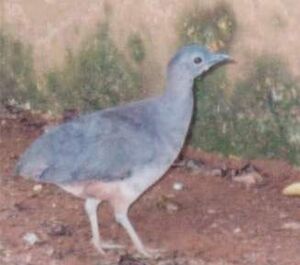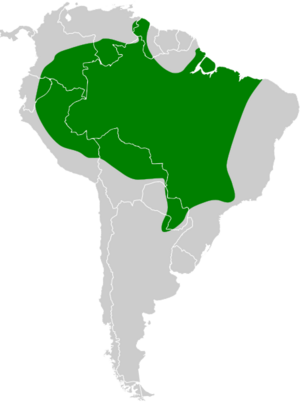Undulated tinamou facts for kids
Quick facts for kids Undulated tinamou |
|
|---|---|
 |
|
| C. undulatus vermiculatus | |
| Conservation status | |
| Scientific classification | |
| Genus: |
Crypturellus
|
| Species: |
undulatus
|
| Subspecies | |
|
C. u. undulatus (Temminck, 1815) |
|
 |
|
The undulated tinamou (Crypturellus undulatus) is a special kind of ground bird. It lives in many different wooded areas across eastern and northern South America.
Contents
What's in a Name?
The undulated tinamou's scientific name, Crypturellus, comes from old Latin and Greek words. Kruptos means "covered" or "hidden". Oura means "tail". And ellus means "small". So, Crypturellus means "small, hidden tail".
The second part of its name, undulatus, comes from the Latin word unda, which means "wave". This name describes the bird's wavy patterns on its feathers.
About Tinamous
All tinamous belong to the family Tinamidae. They are related to large, flightless birds called ratites, like ostriches and emus. However, tinamous are different because they can fly! They are not super strong fliers, but they can get off the ground. Scientists believe tinamous are the closest living relatives to ancient flying birds that all ratites evolved from.
Different Types of Undulated Tinamous
There are several types, or subspecies, of the undulated tinamou. They live in different parts of South America:
- C. u. manapiare is found near the Ventuari River in Venezuela. It might also live in southwestern Amazonas State.
- C. u. simplex lives in southern Guyana, French Guiana, and northeastern Brazil. This is east of the Rio Negro and north of the Amazon River.
- C. u. adspersus is found in Brazil, south of the Amazon River. Its range is from the Tapajós River to the Madeira River.
- C. u. yapura lives in southeastern Colombia, eastern Ecuador, and parts of Peru. It also lives in western Brazil, east to the Rio Negro and the Purús River.
- C. u. vermiculatus is found in eastern Brazil. This includes areas like Maranhão, Tocantins, and Mato Grosso.
- C. u. undulatus lives in southeastern Peru, eastern and northern Bolivia. It also calls the Pantanal region in Brazil, Paraguay, and northern Argentina home.
Sometimes, it's hard to know exactly where one subspecies' area ends and another begins.
What Do They Look Like?
The undulated tinamou is about 28 to 30 centimeters (11 to 12 inches) long. It weighs around 300 grams (0.66 pounds), which is about the same as a can of soda.
Their color can vary depending on the subspecies. They are usually brownish-grey. They have strong, black, wavy patterns on their back and neck. For example, C. u. undulatus is a rich brown with clear bars. But C. u. yapura is darker, more grey, and has only faint wavy lines.
They have a white throat. The rest of their belly area is olive-grey to light brown. Their lower sides have dark wavy patterns. Their bill is black on top and grey underneath. Their legs and feet can be grey, dull yellow, or greenish.
Behavior and Life Cycle
The undulated tinamou makes its nest in a small dip on the ground. The female bird lays about three shiny eggs. These eggs can be pink, light-grey, or a reddish-purple color. If kept in captivity, the eggs hatch in about 17 days.
These birds eat small fruits, seeds, and insects.
Like other tinamous, the undulated tinamou is quite shy. You are more likely to hear one than see it. Their song is a deep, three- or four-note whistle. People describe it as sounding like "com-pra pan" (which means "buy bread" in Spanish) or "Eu sou jaó" (which means "I am undulated tinamou" in Portuguese). They often sing throughout the day.
Where Do They Live?
Undulated tinamous live in areas up to 900 meters (about 2,950 feet) high. They can be found in many different types of wooded places. This includes thick, wet Amazonian forests. They also live in drier, more open savanna-woodlands.
Most undulated tinamous live in the Amazon Basin. But some live in drier areas like the Cerrado region in Brazil. While they usually stay in one place, they might move a little between different habitats during certain seasons.
Conservation Status
Even though people hunt the undulated tinamou in some areas, it is still common in most places where it lives. The IUCN (International Union for Conservation of Nature) lists it as a species of least concern. This means they are not currently at risk of disappearing. Their home range is huge, estimated to be about 8.6 million square kilometers (3.3 million square miles).


